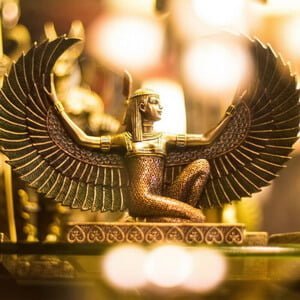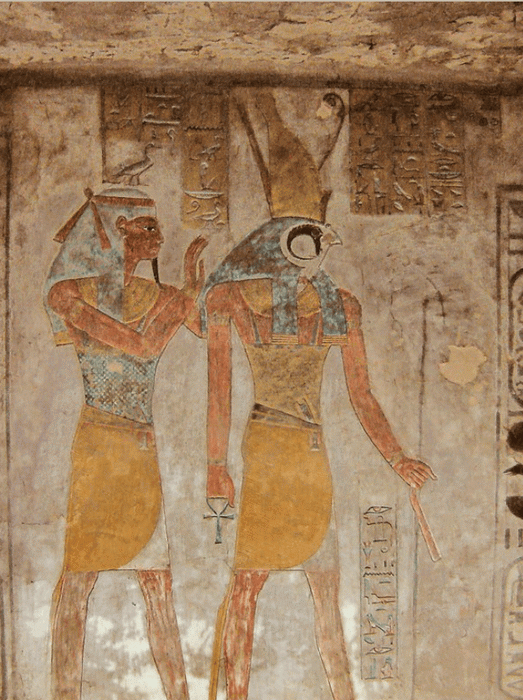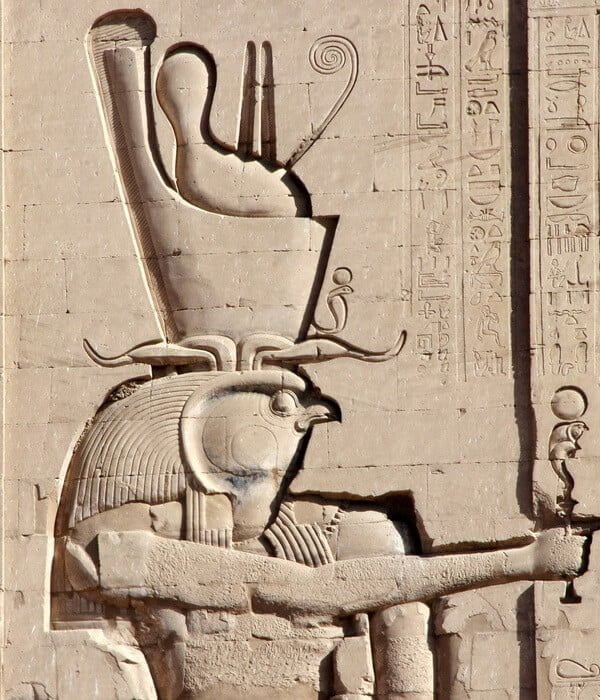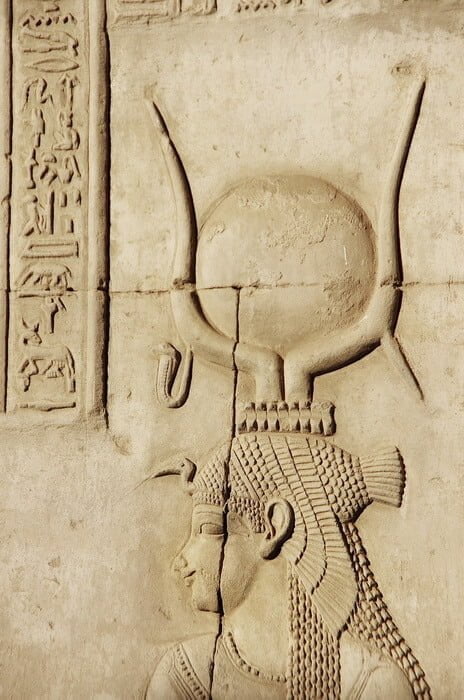Egyptian Gods and Goddesses
The most incredible Egyptian Gods and Goddesses
These are the ancient Egyptian Gods and Goddesses guardians of the underworld and the afterlife, and today we’re listing our most incredible Egyptian Gods and Goddess.
This list will solely feature Egyptian mythology, which means it will not include Pharaohs or Greek Gods.

Sobek, one of the Egyptian Gods and goddesses with a crocodile head
This Ancient Egyptian is one of Egyptian Gods and goddesses, easily identified by his crocodile head, was protected from the perils of the Nile.
And, while Sobek was once thought to be the actual creator of the river and possibly even the planet, he is now mostly linked with fertility.
He was also in charge of military and pharaonic authority.
Sobek is sometimes said to as an extension of both Horus and Ra. He is not the calmest of Gods, but he is undoubtedly one of the most respected.
The Ancient Egyptians were known to mummify crocs to gain preferential treatment from Sobek after death.


Thoth, God of the Moon
Here’s an Egyptian god noted for his calm and calculated demeanor.
Thoth, a multidimensional deity with either an ibis or a baboon head, inspired the exquisite Egyptian art that continues to astonish the globe.
Originally a moon deity, Thoth was subsequently referred to as the designer of the cosmos and the mediator between good and evil.
In other words, Thoth kept Egyptians in line through education and is even credited with inventing writing.
Someone had to keep the cosmos running, and this deity made it appear simple to those who gave adoration.
Geb, God of the Earth
He was the father of snakes and had a great chuckle.
Geb’s thunderous cackles were said to cause earthquakes, while his tears flooded the Earth’s waters.
Sometimes associated with a celestial goose and sometimes responsible for a “global egg,”
Geb is well known for his work on the Nile’s vegetation and as a tomb ruler.
Being both a facilitator and a harmful creature, Geb can potentially upset the ancient Egyptian world.
Above all, Geb had the last word in deciding which of the deceased went to the heavens and which remained on Earth, afflicted by tremendous guilt.


Set [Seth], God of dessert, storms, violence, and foreigners
This Egyptian God was considered aggressive as one of Geb’s sons; in fact, he mutilated his brother, Osiris.
As a result, Set frequently feuded with Osiris’ son, Horus, giving rise to one of Egyptian mythology’s most famous stories.
Set eventually took over the Egyptian deserts to supplement Horus’ control over the agricultural land.
While Seth has become synonymous with domineering techniques.
He has also been criticized for his devious ways, whether within his family hierarchy or by attempting to entice Horus for greater power.
But the crimson desert belonged to Seth.
Horus, God of the sky
As previously stated, this God is significant in the Osiris story.
Horus was revered as a God of the sky, a God of combat, and even a God of hunting, And the Egyptian pharaohs were known to be his human incarnation.
When it comes to his enduring impact on the modern world, there’s the Great Sphinx, sometimes seen as an aspect of Horus, depicting the rising sun.
With different variations of Horus appearing throughout history, he is primarily recognized as a sun deity and the son of Isis and Osiris, placing him as a rival to Set.


Isis, Goddess of motherhood
While this Egyptian Goddess has been associated with various identities and abilities throughout history.
The tale of Isis is sustained by her bond with Horus.
As Isis represented the actual throne, the mother-son bond was essential in the Pharaoh’s existence.
The flooding of the Nile River was frequently ascribed to Isis’ sorrow for her killed brother and husband, Osiris.
And she, along with the Goddesses Hathor and Mut, remained one of Egyptian mythology’s most revered female deities.
Anubis, god of the dead
Even though there are few allusions to this God in traditional Egyptian mythology.
His name dates back to the Old Kingdom of around 2600 B.C., when and where he was commonly represented.
Anubis, described by Plutarch as Isis’ adoptive son, provided afterlife protection.
Generally appearing with a canine head. In essence, this God held the last decision on whether or not the deceased may enter the underworld.
At times, this meant weighing souls and directing them to their ultimate destination.
Anubis appears in art as both a jackal and a wolf and is strongly associated with the embalming and mummification processes.


Ra, God of the sun
This Sun god was widely regarded as the defining God of Egyptian religion by the Fifth Dynasty.
Indeed, the famed Valley of the Kings is frequently claimed as depicting Ra’s rays of sunshine.
And as the alleged “Father of the Gods,” he eventually fused into the God known as Amun-Ra.
This God of the Sun, Underworld, and maybe the Universe.
As depicted in art via his interactions with Horus and Osiris.
He had a cameo of sorts in Steven Spielberg’s “Raiders of the Lost Ark,” which is just one of many reasons we remember him today.
Osiris, God of death, and rebirth
This is the God at the heart of the Osirian story.
He is the son of Geb or Ra (depending on the source), the partner of Isis, and the father of Horus.
According to legend, Osiris was killed by his brother before being assembled by Isis to give birth to Horus.
In other words, this chain of events resulted in Osiris becoming the God of the Dead, He is meeting Pharaohs after their deaths, and guiding them through a voyage of spells and trials.
It is also stated that Osiris once put a stop to cannibalism, restoring life to the Egyptians and converting them to a life of cultivation.


Amun-Ra, God of the sun and creation
Around the 21st century B.C., the King of Gods called Amun was known as “the hidden one” and was associated with creativity.
And, being the creator of not only himself but all that followed, his terrestrial manifestation would become Amun-Ra, the product of the Sun God combining with an unseen god linked with Zeus himself.
As a result, Amun-Ra commanded Egyptians’ daily lives, offering a feeling of serenity and personal significance to earthly and underworld routines.
He has been and will continue to be the distinguishing presence of Egyptian Gods and Goddesses.
Difference between the Egyptian God Ra and Amun-Ra
Amun means “the hidden one,” whereas Ra refers to the sun and has no other connotations.
Originally, Amun and Ra were two distinct gods. Amun was originally a deity of creation, whereas Ra was a god of the sun.
The merger of two gods into one entity, such as Amun-Ra, was a frequent practice in Egyptian religion and resulted in the creation of new meanings and significance for the combined deities.
It is unclear when that combination took place, although the New Kingdom period (about 1550–1077 BCE) is often stated, which places it in a relatively late period.
Amun and Ra eventually merged into one deity, whom the people of Thebes worshipped as their creator sun god. The god was also known as “king of the god” somewhat often.
It is essential to remember that, like Greece, ancient Egypt did not have a united, uniform official religion throughout this period.
In some areas, the worship of certain gods had a higher priority than others.
There were, Egyptian Gods and Goddesses familiar to everyone and adored by everyone
(Like Horus, whose manifestation on Earth was the live Pharaoh, Osiris, or Isis).
Still, these gods were also subject to the cults of individual cities and regions.



